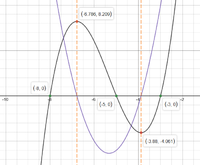Hi all,
I have a math exam on Tuesday and I am pretty much set when it comes to the exam papers, with one of the exceptions being the style of question shown below:
Not really sure how to approach this one. I tried getting the points by going in to my calculator and going to table mode and putting the function in to f(x) and then starting at -1 and ending at -9 in steps of 1. This just kept giving 'MATH ERROR'.
The next part of the questions asks to :
I am unsure how to go about it after getting the derivative of the function, which I calculated to be 3x^2+32x+79. I am unsure how to get the points from this derivative.
Could someone be so kind to walk me through this question from start to end. Thanks!
I have a math exam on Tuesday and I am pretty much set when it comes to the exam papers, with one of the exceptions being the style of question shown below:
A function is defined as y=(x+3)(x+5)(x+8). Sketch this curve on graph paper showing the 3 points where it crosses the X axis (between the x values of -1 and -9).
Not really sure how to approach this one. I tried getting the points by going in to my calculator and going to table mode and putting the function in to f(x) and then starting at -1 and ending at -9 in steps of 1. This just kept giving 'MATH ERROR'.
The next part of the questions asks to :
Find the derivative of y=(x+3)(x+5)(x+8) and plot on the same graph paper as part (a).
I am unsure how to go about it after getting the derivative of the function, which I calculated to be 3x^2+32x+79. I am unsure how to get the points from this derivative.
Could someone be so kind to walk me through this question from start to end. Thanks!


